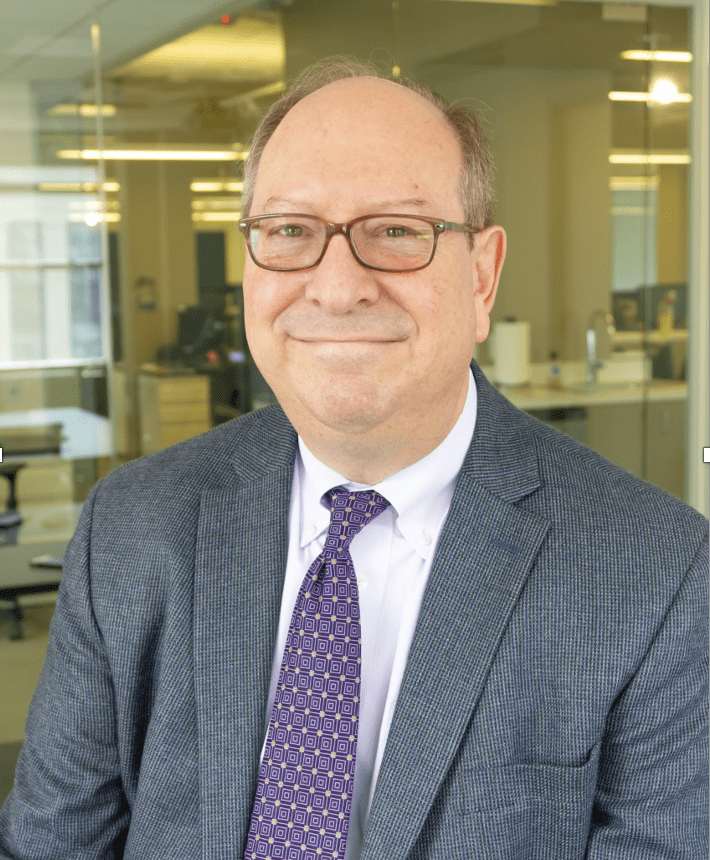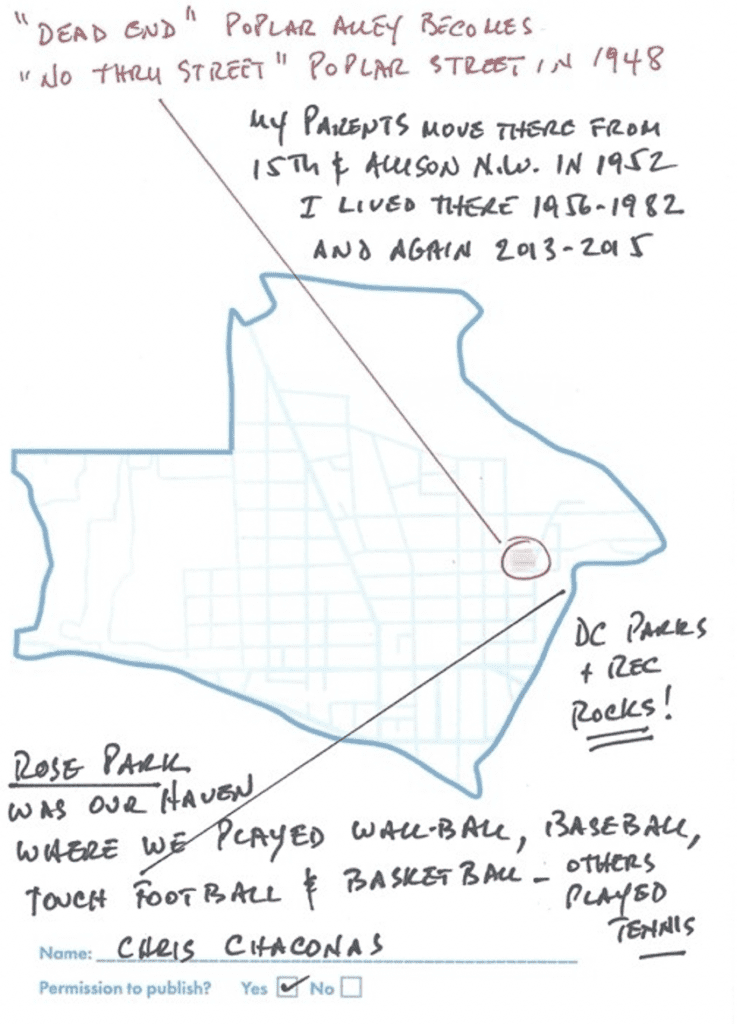Mapping Georgetown: Growing Up on Poplar Street, NW
By • January 31, 2022 2 1943


Chris Chaconas grew up at 2718 Poplar St. NW. in the yellow house with the green shutters shown here (middle). Photo courtesy of Chris Chaconas (from 2015.)
In our Mapping Georgetown project, it’s been a delight to discover how Georgetown’s alleyways have yielded such fascinating local histories.
Poplar Street, NW in Georgetown. This dead-end street with the enchanting wide brick steps leading up to 28th St, was the home to some of Washington’s most interesting people.
One resident who grew up here — Carolyn Hagner (Callie) Shaw — published The Social List of Washington which was “considered by many to be one of the most important books in the nation’s capital” according to The Washington Post. Neville Waters and Gwen Ames (the subjects of some of our earlier stories) were childhood friends here, to name a few. For those who grew up here, Rose Park, Rosenblatt’s (the legendary predecessor to Stachowski’s) and 7-Eleven provide the stuff of long-cherished memories.
In today’s Mapping Georgetown story, we feature Chris Chaconas’s life experiences from Poplar Street, as engaging as his neighborhood!
Chris Chaconas’s Mapping Georgetown Story:
My parents were native Washingtonians who lived at 15th and Allison Streets NW before moving to Poplar Street in 1952. Georgetown was very different back then and hadn’t yet earned its reputation as a toney neighborhood. In fact, many of my parents’ contemporaries thought they were a bit crazy to move to Georgetown, especially to an alley! And yet, they fell in love with the street as it reminded my mother of an English mews.
My father, who was an architect, provided me with the background about the street. It was first known as Poplar Alley. Where the steps now lead to 28th Street [used to be] a wall that served as a venue for crime. In 1948, a developer who wished to renovate the houses, petitioned the city to rename Poplar Alley to Poplar Street, thinking (correctly) that no one would want to buy a house in an alley. The other marketing coup was to remove the sign “Dead End” at the entrance on 27th Street and replace it with “No Thru Street” which sounds much, much better to prospective buyers.
I arrived in 1956 and lived there until 1982. There were a few notables who lived there. First, was Carolyn Shaw who published The Green Book, Washington’s social register. Next door to Mrs Shaw lived the Ames family. They had a daughter, Gwen, who was about my age. Mr. Ames worked in the Kennedy administration. In the mid-60s the family moved to Reston, which was at that time just getting started. Tragically, Gwen became famous some years later as the first homicide in Reston when she was murdered walking home from a dance in 1972. Her murder is still unsolved.
At the end of Poplar Street was Georgetown Floorcoverings. After it moved to 3233 Water Street, it became Walsh-McLellan Interiors and then a private residence. Poplar Street is where I first learned to ride a bike. A great place to do that because of virtually no traffic and it was just outside our front door. As I got a little older, nearby Rose Park became the hub for fun. Fun as defined by playing basketball, wall ball, touch football, softball and baseball. To this day I’m a big fan of Parks and Recreation.
As a youngster, I worked delivering groceries and sweeping up at Rosenblatt’s, now Stachowski’s, at the corner of 28th and P. When the 7-11 opened on P Street, it was a very big deal. Slurpees were just about the best invention ever after a day playing ball in the Summer. I could turn my allowance money into bubble gum and baseball cards too.
When I returned to live on Poplar Street between 2013 and 2015, it didn’t feel quite the same as there were clearly fewer children in the neighborhood. No one was out playing catch in the “alley,” as my dad always called it. Nor were the playing field and basketball court at Rose Park as busy as in the 60s and 70s. The tennis courts were still popular, however. Thomas Wolfe famously wrote “You can’t go home again.” I knew exactly what he meant.
My mother was a French major at The Catholic University of America and was both a francophone and francophile. While English has since surpassed French as the diplomatic language, it was still a force in world affairs in the mid-fifties. The Ecole Française Internationale opened in 1955 at 2118 Kalorama Road NW, up the street from the French ambassador’s residence and around the corner from the French Consulate on Wyoming Avenue. The school accepted young children then, so I entered kindergarten in 1959 (3 months shy of my 3rd birthday). All subjects were taught in French using the curriculum and textbooks approved by the French ministry of education. Looking back, being immersed in the French language and culture was a wonderful experience that would pay dividends in my adult life. Career-wise, combining my language skills with my International Business degree from Georgetown led me to work in Paris (1985-1987) for Electronic Data Systems as Manager of Finance and Administration of EDS’ Southern Europe Division. Besides France, I had oversight over Spain, Italy and Portugal. While we were part of General Motors at the time, the experience was like a start-up. It involved everything from recruiting a team of professionals in finance, accounting and human resources; to securing office space; to acquiring a company with 550 employees. All in 23 months.
In the 90’s I flipped the paradigm and worked for a French-based company, Alcatel, here in the US. Not a day went by when I didn’t use my French. However, the most satisfying aspect is the friendships I made and retained these many years. I’m still in touch with several of my French school teachers, classmates and former colleagues.

Chris Chaconas’s story-map for the Mapping Georgetown project.

Chris Chaconas with his mother Sophia. Photo courtesy Chris Chiconas.
—
To learn more about the Mapping Georgetown project see https://georgetowner.com/articles/2021/07/19/marilyn-butlers-vision-for-mapping-georgetown/.
To submit your Georgetown recollections to Mapping Georgetown go to www.mappinggeorgetown.com or visit the Georgetown Public Library to pick up a physical map-story form to fill out.
Marilyn Butler can be reached at marilyn.butler@gmail.com.


Chris, I enjoyed reading your historical article of growing up in Georgetown! It brought back so many memories from when my family moved to the area in the early 60s. One of my Mother’s best friends, Mrs. Georgia Pappas (Nina P. Pournaras and her brother, Dr. Stephen Pappas) lived above the Chaconas Brothers store in her building and she usually rented the top floor apartment to young womean graduates of Georgetown Univ.
Such a neat view into Poplar Street for this East Georgetown denizen. Thanks so much, Chris!